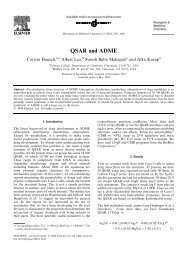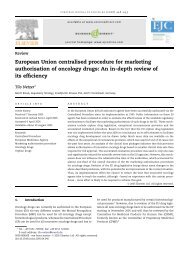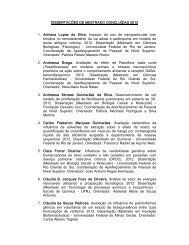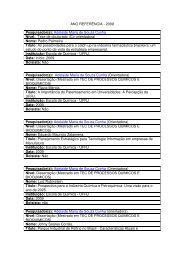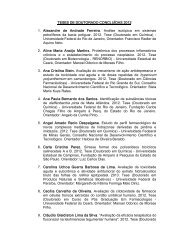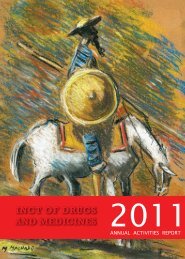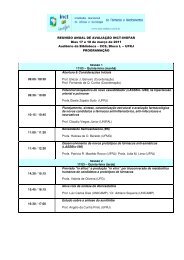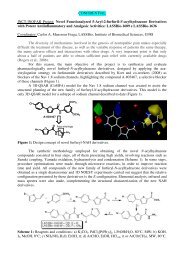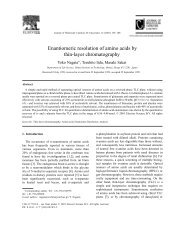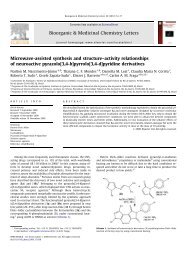View - ResearchGate
View - ResearchGate
View - ResearchGate
- No tags were found...
You also want an ePaper? Increase the reach of your titles
YUMPU automatically turns print PDFs into web optimized ePapers that Google loves.
4344 Journal of Medicinal Chemistry, 2004, Vol. 47, No. 18 PerspectiveFigure 4. Schematic illustration of the “HPLC biogram” approach.activity without any effort to isolate or structurallycharacterize the metabolites. This method potentiallyhas higher throughput capability and utilizes the mostrecent advances in biotechnology and analytical instrumentation.The bioassay methods may be based on theassessment of the pharmacological activity using in vitroligand binding, 36,37 cell-based assays, 35 or in vivo pharmacologicalassays. 33 Metabolites can be generated byany of the in vitro and in vivo methods discussed in thefollowing sections. Biological activity in the samplemixture can then be evaluated as is or after fractionationof the sample mixture by using chromatographictechniques. The structural identity of the active metabolitecan then be determined and its in vitro and invivo activity confirmed after isolation and/or afterfurther biological or chemical synthesis.A systematic approach to profiling active metabolitesusing a 96-well plate format was recently described. 38The approach is based on rapid bioassay-guided metabolitedetection and characterization, and a schematicillustration of this bioassay “HPLC biogram” method isshown in Figure 4. Drug metabolite mixtures (generatedby various methods described below) are separated andfractions collected into 96-well plates. The fractions arethen subjected to one or more relevant activity (e.g.,receptor ligand binding) assays. Fraction collectionutilizes a time-based protocol, resulting in a directrelationship between a well’s position in the plate anda corresponding area on the HPLC chromatogram. Thisallows assignment of activity to a particular componentof the mixture. The active peaks are correlated back toHPLC/UV/MS profiles and are followed up with UV/MSspectral analysis for structure characterization.The “biogram” methodology has been used in thediscovery of bioactive natural products and other mixtures,including but not limited to evaluation of substancesof interest (hits) from initial high-throughputscreens, biological assessment of impurities and racemicmixtures (chiral HPLC required), and isolation of activecomponent in a mixture. 39 Figure 5 shows an exampleof the use of the “biogram” method in detecting andcharacterizing a very minor but bioactive metabolite.When applied in metabolite studies, the “biogram”approach allows early recognition of active metabolitesin a rapid and efficient manner while minimizing timeand effort spent on inactive metabolites. The “biogram”approach also facilitates decision-making in initiatingreisolation or scale-up of active metabolite for fullstructural and biological evaluation.There are a number of important determinants for asuccessful “biogram” experiment. The fundamentalrequirement is the availability of a robust bioassay. Todetect a minor active metabolite, the bioassay employedshould be as sensitive as the analytical assay (e.g., LC/UV/MS) and should have a good “signal/noise” ratio. Ifthese conditions are met, the biogram method canprovide rapid and efficient detection of minor activemetabolites previously undetected by physical methods.False positives, such as interfering endogenous materials,detergents, pigments, metal ions, etc., are animportant consideration in any biogram study. Therefore,it is very important to run appropriate blank andcontrol samples. The “biogram” method usually consumesa relatively small amount of metabolite sample(mixture). Nevertheless, a larger quantity of metabolitemixture may be needed for any follow-up experimentsand can be achieved by several biological transformationtechniques described below.Methods for Generation of MetabolitesThere are a number of in vitro and in vivo biotransformationtechniques available to generate metabolites.



